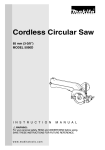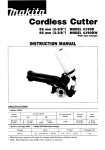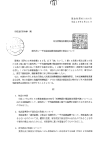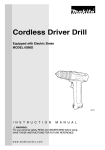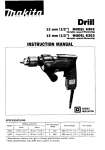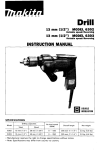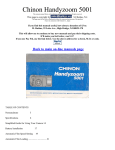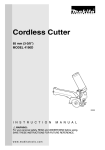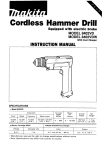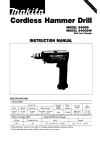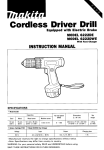Download Makita 5090D Instruction manual
Transcript
Cordless Circular Saw Models 5090D, 5090DW (3 85" ,I1) With Fast Charger INSTRUCTION MANUAL SPECIFICATIONS Blade diameter 85" (3 3/8") Cutting depth 90" 45" I 0-22" (0 - 55/64") I 2-18" (5/64 - 45/64') Battery Cartridge 9000 Voltage 9.6 V 1 Chargina time 1 Hr. I I No load speed (RPM) Overall length 1,000 I I 313 mm (12 3/8") Net weight I 1.8 kg. (4 Ibs.) Model DC9700A Fast Charger Input A.C. only 50 Hz - 60 Hz. I Output D.C. 7.2 V - 9.6 V IMPORTANT SAFETY INSTRUCTIONS FOR ALL TOOLS - WARNING: When using electric tools, basic safety precautions should always be followed to reduce the risk of fire, electric shock, and personal injury, including the following: 1. Keep work area clean. Cluttered areas and benches invite injuries. 2. Consider work area environment. Do not use power tools in damp or wet locations. Keep work area well lit. Do not expose power tools to rain. use tool in presence of flammable liquids or gases. Do not 3. Keep children away. All visitors should be kept away from work area. Do not let visitors contact tool or extension cord. 4. Store idle tools. When not in use, tools should be locked-up or stored in a dry, high place - out of reach of children. 5. Do not force tool. It will do the job better and safer at the rate for which it was intended. 6. Use correct tool. Do not force small tool or attachment to do the job of a heavy-duty tool. Do not use tool for purpose not intended. 7. Dress appropriately. Do not wear loose clothing or jewelry. It can be caught in moving parts. Rubber gloves and non-skid footwear are recommended when working outdoors. Wear protective hair covering to contain long hair. 0. Use safety glasses. Also use face or dust mask if cutting operation is dusty. 9. Do not abuse cord. Never carry tool by cord or yank it to disconnect from receptacle. Keep cord from heat, oil, and sharp edges. 10. Secure workpiece. Use clamps or a vise to hold work. It is safer than using your hand; it also leaves both hands free to operate tool. 11. Do not over-reach. Keep proper footing and balance at all times. 12. Maintain tools with care. Keep tools sharp and clean for better and safer performance. Follow instructions for lubricating and changing accessories. Inspect tool cords periodically and, if damaged, have repaired by authorized service facility. Inspect extension cords periodically and replace if damaged. Keep handles dry, clean, and free from oil and grease. 13. Disconnect tools when not in use, before servicing, and when changing accessories, such as blades, bits, and cutters. 14. Remove adjusting keys and wrenches. Check to ensure that keys and adjusting wrenches are removed from tool before turning the tool on. 15. Avoid unintentional starting. Do not carry plugged-in tool with finger on switch. Be sure switch is OFF when plugging in. 2 16. Outdoor use extension cords. When tool is used outdoors, use only extension cords intended for outdoor use and so marked. 17. Stay alert. Watch what you are doing. Do not operate tool when you are tired. 18. Check damaged parts. Before further use of the tool, a guard or other part that is damaged should be carefully checked to determine that it will operate properly and perform its intended function. Check for alignment of moving parts, binding of moving parts, breakage of parts, mounting, and any other conditions that may affect tool operation. A guard or other part that is damaged should be properly repaired or replaced by an authorized service center unless otherwise indicated elsewhere in this instruction manual. Defective switches should be replaced by an authorized service center. Do not use tool if the switch does not turn the tool on and off. 19. Guard against electric shock. Prevent body contact with grounded surfaces, for example: pipes, radiators, ranges, refrigerator enclosures. 20. Replacement parts. When servicing, use only identical replacement part. VOLTAGE WARNING: Before connecting the tool to a power source (receptacle outlet, etc.) be sure the voltage supplied is the same as that specified on the nameplate of the tool. A power source with voltage greater than that specified for the tool can result in SERIOUS INJURY to the user-as well as damage to the tool. If in doubt, DO NOT PLUG IN THE TOOL. Using a power source with voltage less than the nameplate rating is harmful to the motor. IMPORTANT SAFETY INSTRUCTIONS FOR BAlTERY 1. Always Cover the Battery Terminals with the battery cover when the battery cartridge is not in use. 2. Do not short the Battery Cartridge: i. Do not touch the terminals with any conductive material. ii. Avoid storing battery cartridge in a container with other metal objects such as nails, coins, etc. iii. Do not expose battery cartridge to water or rain. A battery short can cause a large current flow, overheating, possible burns, and even a breakdown. 3. Do not store the tool and Battery Cartridge in locations where the temperature may reach or exceed 50°C (122°F). 4. Do not incinerate the Battery Cartridge even if it is severely damaged or completely worn out. The battery cartridge can explode in a fire. 3 IMPORTANT SAFETY INSTRUCTIONS continued FOR BATTERY AND CHARGER 1. Before using battery charger, read all instructions and cautionary markings on: i. battery charger ii. battery iii. product using battery. 2. To reduce risk of injury, charge only MAKITA Battery 7000,9000, or 9100. Other types of batteries may burst causing personal injury and damage. 3. Do not disassemble charger or battery cartridge; take it to a qualified serviceman when service or repair is required. Incorrect reassembly may result in a risk of electric shock or fire. 4. Do not charge Battery Cartridge when temperature is BELOW 10°C (50°F) or ABOVE 40°C (104OF). FOR CHARGER 1. SAVE THESE INSTRUCTIONS-This manual contains important safety and operating instructions for battery charger. 2. Do not expose charger to rain or snow. 3. Use attachment recommended or sold only by the battery charger manufacturer. Use of any other attachment may result in a risk of fire, electric shock, or injury to persons. 4. Do not operate charger if it has received a sharp blow, been dropped, or otherwise damaged in any way; take it to a qualified serviceman. 5. To reduce risk of electric shock, unplug charger from outlet before attempting any maintenance or cleaning. Turning off controls will not reduce this risk. 6. Do not attempt to use a step-up transformer, an engine generator, or a DC power receptacle. 7. Do not allow anything to cover or clog the charger vents. SAVE THESE INSTRUCTIONS 4 IMPORTANT SAFETY INSTRUCTIONS continued FOR CORD 1. To reduce risk of damage to electric plug and cord, pull by plug rather than by cord when disconnecting charger. 2. Make sure cord is located so that it will not be stepped on, tripped over, or otherwise subjected to damage or stress. 3. An extension cord should not be used unless absolutely necessary. Use of improper extension cord could result in a risk of fire and electric shock. If extension cord must be used, make sure that: i. Pins on plug of extension cord are the same number, size, and shape as those of plug on charger. ii. Extension cord is properly wired and in good electrical condition. iii. Wire size is at least as large as the one specified in the table below. RECOMMENDED MINIMUM AWG SIZE FOR EXTENSION CORDS FOR BATTERY CHARGERS Length of Cord (Feet) 25 50 100 150 AWG Size of Cord 18 18 18 16 FOR CORD AND CHARGER 1. Do not operate charger with damaged cord or damaged plug - replace them immediately. SAVE THESE INSTRUCTIONS 5 IMPORTANT SAFETY INSTRUCTIONS continued FOR USE OF SAW 1. Be aware that this tool is always in an operating condition because it does not have to be plugged into an electrical outlet. 2. Keep Guards In Place and In Working Order. Never wedge or tie lower guard open. Check operation of lower guard before each use. Do not use if lower guard does not close briskly over saw blade. CAUTION: If saw is dropped, lower guard may be bent, restricting full return. 3. Keep Blades Clean and Sharp. Sharp blades minimize stalling and kickback. 4. DANGER: Keep Hands Away From Cutting Area. Keep hands away from blades. Do not reach underneath work while blade is rotating. Do not attempt to remove cut material while blade is moving. CAUTION: Blades coast after turn off. 5. Support Large Panels. Large panels must be supported as shown in Fig. 1 to minimize the risk of blade pinching and kickback. When cutting operation requires the resting of the saw on the work piece, the saw should be rested on the larger portion and the smaller piece cut off. To avoid kickback, do support board or panel near the cut. Fig. 1 Don't support board or panel away from the cut. Fig. 2 6. Use Rip Fence. Always use a fence or straight edge guide when ripping. 6 7. Guard Against Kickback. Kickback occurs when the saw stalls rapidly and is driven back towards the operator. Release switch immediately if blade binds or saw stalls. Keep blades sharp. Support large panels as shown in Fig. 1. Use fence or straight edge guide when ripping. Do not force tool. Stay alert exercise control. Do not remove saw from work during a cut while the blade is moving. NEVER place your hand or fingers behind the saw. If kickback occurs, the saw could easily jump backwards over your hand, possibly causing severe injury (see Fig. 3). Fig. 3 8. Lower Guard. Raise lower guard with the retracting handle. 9. Adjustments. Before cutting be sure depth and bevel adjustments are tight. 10. Use Only Correct Blades In Mounting. Do not use blades with incorrect size holes. Never use defective or incorrect blade washers or bolts. 11. Avoid Cutting Nails. Inspect for, and remove, all nails from lumber before cutting. I 12. Operate with proper hand support and proper workpiece support (see Fig. 4). I A typical illustration of proper hand support and workpiece support. Fig. 4 WARNING: It is important to support the workpiece properly and to hold the saw firmly to prevent loss of control which could cause personal injury. Fig. 4 illustrates typical hand support of the saw. 7 SAFETY INSTRUCTIONS FOR USE OF SAW continued 13. Place the wider portion of the saw base on that part of the workpiece which i s solidly supported, not on the section that will fall off when the cut is made. If the workpiece is short or small, clamp it down. DON’T TRY TO HOLD SHORT PIECES BY HAND! Fig. 5 illustrates the CORRECT way to cut off the end of a board. Fig. 6 illustrates the WRONG way to cut off the end of a board. Fig. 5 14. Fig. 6 Never attempt to saw with the circular saw held upside down in a vise. This is extremely dangerous and can lead to serious accidents. Fig. 7 15. Before setting the tool down after completing a cut, be sure that the lower (telescoping) guard has closed and the blade has come to a complete stop. SAVE THESE INSTRUCTIONS 8 BATTERY CAUTION: Always switch off the tool before insertion or removal of the battery cartridge. Read the Safety Instructionsfor battery on pages 3 and 4. Installing or Removing the Battery To remove the battery cartridge: 1. Pull out the set plate on the tool 2. Grasp both sides of the cartridge while withdrawing it from the barrel. To insert the battery cartridge: 1 . Align the tongue of the battery cartridge with the groove in the housing. 2. Slip the cartridge into place. 3. Snap the set plate back into place. Be sure to close the set plate fully before using the tool. CAUTION: Do not use force when inserting the battery cartridge. If the cartridge does not slide in easily, it is not being inserted correctly. Charging the Battery CAUTION: YOUR NEW BATTERY CARTRIDGE IS NOT CHARGED. YOU WILL NEED TO CHARGE IT BEFORE USE. Read Safety instructions on page 4 before charging battery. To charge the battery: 1. Plug the fast charger into your power source. 2. Insert the battery cartridge so that the plus (+) and minus (-) terminals on the battery cartridge are on the same sides as their respective markings on the fast charger. 3. Insert the cartridge fully into the port so that it rests on the charger port floor. 4. Press the start button (red). The charging light will come on and charging will begin. (If the charging light does not come on, see NOTE on page 10). 5. When the charging light goes out after about one hour, you may remove the fully charged battery cartridge. 6. After charging, unplug the charger from the power source. Charging continued 9 BATTERY continued Charging the Battery continued NOTE: If the charging light does not come on: i. Press the Reset button (yellow) ii. Then press the Start button (red). If the charging light goes out within 10 seconds even after pressing the Reset button and Start button a couple of times, the battery cartridge is dead. (CAUTION: Wait for more than 5 seconds after the charging light goes out before pressing the Reset button again). Replace the battery cartridge with a new one. CAUTION Do not keep the button pressed in with tape, etc. or the circuit will not function properly. Also, a malfunction of the charger may result possibly causing overheating, etc. If you try to charge a cartridge from a just-operated tool, sometimes the charging light will not come on. If this occurs, let the cartridge cool off for a while, then re-insert it and try to charge it once more. If you wish to charge two battery cartridges, allow 15 minutes between chargings on the fast charger. Recycling the Battery The way to dispose of a Makita battery is to recycle it. The law prohibits any other method of disposal. To recycle the battery: 1. I-I Ni-Cd Remove the battery from the tool. 2. a). Take the battery to your nearest Makita Factory Service Center OR b). Take the battery to your nearest Makita Authorized Service Center or Distributor that has been designated as a Makita battery recycling location. Call your nearest Makita Service Center or Distributor to determine the location that provides Makita battery recycling. See your local Yellow Pages under "Tools- Electric." 10 SAW BLADE CAUTION: Always be sure that the tool is switched off and the battery cartridge is removed before installing or removing the blade. Use only the Makita hex wrench to remove and install the blade. Removing Saw Blade To remove the blade: 1. Press the blade stopper pin and insert it through the hole in the blade so that the blade cannot revolve. 2. Use the hex wrench to loosen the bolt. 3. Remove the bolt, flange, and blade. Installing Saw Blade To install the blade: 1. Place the blade over the spindle, With teeth pointina up at the front of the tool. 2. Place the flange over the blade. 3. Insert bolt into blade and flange. 4. Press the blade stopper pin and insert it through the hole in the blade so that the blade cannot revolve. I I 5. Use the hex wrench to tighten the bolt, flange, and blade in place. BE SURE TO TIGHTEN THE BOLT SECURELY. Hex Wrench Storage When not in use, the hex wrench can be conveniently stored. 11 CUlTlNG ADJUSTMENTS CAUTION: Remove battery before making any cutting adjustments. Use only the Makita hex wrench to loosen the bolts. Adjusting Depth of cut To adjust depth of cut: 1. Using the hex wrench, loosen the bolt (A) on the depth guide. 2. Move the base up or down. 3. At the desired depth of cut, secure the base by tightening the bolt (A). Bevel Cutting For bevel cutting: 1. Using the hex wrench, loosen the bolt (A) on the depth guide. 2. Loosen the bolt (6) on the bevel scale plate. 3. Set the desired angle (OD- 45") by tilting accordingly. 4. Tighten bolts (A) and (B) securely. CAUTION: After adjusting depth of cut and bevel cutting angle, be sure to tighten the bolts (A) and (6) securely. Sighting For straight cuts: 1. Align the edge of the base with your cutting line on the workpiece. For 4 5 O bevel cuts: 1. Align the notch in the front of the base with your cutting line on the workpiece. 12 0PERAT10N CAUTION: Read Safety Instructionson pages 6,7, and 8 before operating saw. Switch Action NOTE: To prevent the trigger from being pulled accidentally, a lock-off lever is provided as a safety feature. To start the tool: 1. Slide the lock-off lever in the direction of the arrow 2. Pull the trigger switch. To stop the tool: 1. Release the trigger switch. Operating the Tool CAUTION: Before inserting the battery cartridge into the tool, always check to see that the trigger switch actuates properly and returns to the "OFF" position when released. To a,perate the tool: 1. Hold the tool firmly. 2. Set the base plate on the workpiece to be cut without the m e makina anv contact. 3. Turn the tool on and wait until the blade attains full SDeed. 4. Then move the tool forward over the workpiece surface, keeping it flat and advancing smoothly until the sawing is completed. Tip: I Base I To make a clean cut, keep your sawing line straight and keep your speed 0; advance constant. CAUTION: If you use the tool continuously until the battery has discharged, allow the tool to reset for 15 minutes before proceeding with a fresh battery. 13 MAINTENANCE CAUTION: Always be sure that the tool is switched off and the battery cartridge removed before attempting to perform inspection or maintenance. To maintain product SAFETY and RELIABILITY, repairs, carbon brush inspection and replacement, or any other maintenance and adjustment should be performed by Makita Authorized or Factory Service Centers, always using Makita replacement parts. OPTIONAL ACCESSORIES The accessories listed in this manual are available at an extra cost from your Makita distributor or Makita factory service center. Service centers are listed on the warranty card packed with your tool. CAUTION: These accessories or attachments are recommended for use with your Makita tool specified in this manual. The use of any other accessories or attachments might present a risk of injury to persons. These accessories or attachments should be used onlv in the DroDer and intended manner. Hex Wrench part no. 783202-0 Battery Holster Holster holds extra battery part no. 823033-3C Battery Cover part no. 414938-7 Battery Cartridge 9OOO part no. 632007-4 Fast Charger Model DC9700A part no. 113103-2 Charger 12V for car Model DC9112 part no. 113110-5 Combination Saw Blade For rip and cross-cut work. Has fewer teeth than cross-cut blade for faster cutting. Plywood Saw Blade For smooth splinter-free cutting of plywood and other laminates. 14 Sept - 25 - '87 EN CORDLESS CIRCULAR SAW Model 5090D 85 mm (33/8'') Note: The switch and other part configurations may differ from country to country. 15 CORDLESS CIRCULAR SAW PART DESCRIPTION Item Qty. Used 1 3 1 1 1 I 3 I 1 1 1 1 No. 5 8 9 10 11 12 13 14 15 16 17 18 19 20 5 1 1 1 1 1 Item Qty. Description No. Used Description -- Housing Set (with item 5) Set Plate Housing Set (with item 1) Tension Spring 5 Pan Head Screw M4x14 (with Washer) Blade Case Gear Plane Bearing 5 Leaf Spring Name Plate Pan Head Screw M4x25 (with Washer) Switch DC Motor 9.6 V Plane Bearing 4 Gear Complete 1 1 - 6 7 Plane Bearing 4 21 22 23 24 25 26 27 28 29 30 31 32 41 42 43 44 1 1 1 1 1 1 3 1 1 1 1 I 1 1 1 1 Pin 5 Compression Spring 6 Stop Ring E-4 Safety Cover Outer Flange 28 Hex. Socket Head Bolt M5x12 Countersunk Head Screw M5x16 Flat Washer 5 Hex Socket Head Bolt M5x10 Base Flat Washer 5 Hex. Socket Head Bolt M5x10 Lock Off Lever Switch Lever Compression Spring 3 Battery Holder MAKITA LIMITED ONE YEAR WARRANTY WARRANTY POLICY ' Every Makita tool is thoroughly inspected and tested before leaving the factory. It is warranted to be free of defects from workmanship and materials for the period of ONE YEAR from the date of original purchase. Should any trouble develop during this one-year period, return the COMPLETE tool, freight prepaid, to one of Makita's Factory or authorized Service Centers. If inspection shows the trouble is caused by defective workmanship or material, Makita will repair (or at our option, replace) without charge. This Warranty does not apply where: repairs have been made or attempted by others, repairs are required because of normal wear and tear, the tool has been abused, misused or improperly maintained, alterations have been made to the tool. IN NO EVENT SHALL MAKITA BE LIABLE FOR ANY INDIRECT, INCIDENTAL OR CONSEQUENTIAL DAMAGES FROM THE SALE OR USE OF THE PRODUCT. THIS DISCLAIMER APPLIES BOTH DURING AND AFTER THE TERM OF THIS WARRANTY. MAKITA DISCLAIMS LIABILITY FOR ANY IMPLIED WARRANTIES, INCLUDING IMPLIED WARRANTIES OF "MERCHANTABILITY"AND "FITNESS FOR A SPECIFIC PURPOSE," AFTER THE ONE-YEAR TERM OF THIS WARRANTY. This Warranty gives you specific legal rights, and you may also have other rights which vary lrom state to state. Some states do not allow the exclusion or limitation of incidental or consequential damages, so the above limitation or exclusion may not apply to you. Some states do not allow limitation on how long an implied warranty lasts, so the above limitation may not apply to you. Makita Corporation of America 2650 Gainesville Hwy Buford, GA 30518 A00205A6 PRINTED IN USA MCNRevised 4-93 1995-7-4D
















